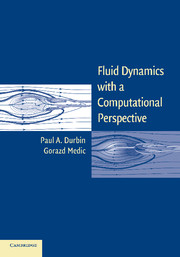6 - Turbulent Flow
Published online by Cambridge University Press: 28 January 2010
Summary
It is likely that most questions the reader might pose about turbulent flow have no satisfactory answer - questions like. What is its cause? How can equations as innocuous as the Navier-Stokes momentum equations produce such complex solutions? How can we describe it? How do we predict its properties? and so on. The phenomenon is common experience: turbulent eddying is seen in smoke billowing above a large fire, in dust clouds rising from an explosion, in the wake of a last-moving boat; it is heard in the roar of a jet engine, in the wind rushing over an automobile; it is fell when an airplane bobs up and down in it or when a stiff breeze blows in one's face. Turbulence is an essential element of many processes. A text on fluid mechanics is not complete without a chapter on turbulence. That said, we provide, in this chapter, an introduction to computation of turbulent flow. The reader interested in a more thorough treatment of the subject can consult books entirely devoted to turbulence, such as Pope (2000).
The word turbulence conjures up the notion of randomness. It has entered everyday vocabulary, divorced from the field of fluid mechanics. It evokes images of roiling, churning, and disorder. These are valid definitions, but in fluid flow it is often less severe than vernacular usage suggests. A 10% level of velocity fluctuation may be considered to be substantial. Turbulence is best defined as the irregular component of motion that occurs in fluids when the Reynolds number is sufficiently high. The irregularity may be mild or it may be severe.
- Type
- Chapter
- Information
- Fluid Dynamics with a Computational Perspective , pp. 210 - 263Publisher: Cambridge University PressPrint publication year: 2007



